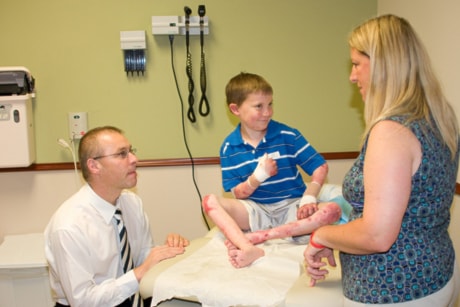TORONTO — As children’s diseases go, it is surely one of the most cruel. Skin that blisters and turns into gaping sores with the merest bump or pressure. Open wounds in the mouth and digestive tract that make eating painful or even impossible. And in the most severe cases, certain death from cancer.
This is the face of a rare genetic disease called epidermolysis bullosa, or EB — and researchers believe they have found a treatment that will ease the suffering of those afflicted and help prolong their lives.
An international team led by the University of Minnesota has used stem cells in transplanted bone marrow to repair the skin and other affected tissues in children with one form of the disease, known as recessive dystrophic epidermolysis bullosa, or RDEB.
The stem cells travel to the site of injury and provide a protein missing in EB patients that is needed to build collagen, the scaffold that gives stability to skin and tissues that line the mouth and digestive tract.
“We do know that these cells are contained in the bone marrow and cord blood that we infuse because we see these cells go to the skin,” said co-principal investigator Dr. Jakub Tolar, a pediatric bone marrow transplant specialist at the university’s Amplatz Children’s Hospital.
“What I think is the skin injury calls upon these cells and makes them migrate to the site of injury,” Tolar said Wednesday from Minneapolis. “So we think that we are sort of tapping into the mechanism and the pathway that’s already established in these children.”
“We are just for the first time in their lives . . . providing them with building blocks, with the cells that are able to heal their wounds.” The most severe form of the genetic disease affects about one to two children out of every 100,000 born. Many die in infancy or childhood from infection, while others do not survive beyond their 20s or 30s because they develop an aggressive form of skin cancer.
Tolar and John Wagner, director of pediatric blood and marrow transplantation, began testing the treatment in fall 2007 in a small number of children with severe RDEB.
All the children given transplants have responded to the therapy in varying degrees, say the researchers, whose paper is published in this week’s issue of the New England Journal of Medicine.
“To understand this achievement, you have to understand how horrible this disease actually is,” Wagner said in a release. “From the moment of birth, these children develop blisters from the slightest trauma which eventually scar. They live lives of chronic pain, preventing any chance for a normal life. “My hope is to do something that might change the natural history of this disease and enhance the quality of life of these kids.”
Until receiving a bone marrow transplant in December 2008, eight-year-old Keric Boyd of Nixa, Mo., spent his life in constant pain and swaddled in bandages, soft but sturdy shoes and even gloves. He could eat, but only soft food and lots of protein- and calorie-boosted liquids. “Keric’s life was really sheltered in some ways because any type of small trauma would cause these large bolus blisters to form,” said his mother Krista Boyd, recalling that the youngest of her three children was born without any skin on his legs, allowing her to clearly see his tendons, ligaments and blood vessels.
“The only treatment at the time was protection and wound care,” said Boyd, noting that any activity that might harm him was discouraged. “He was like in a padded bubble all the time. His life was centred around all the dressings.”
Today, following infusion of bone marrow donated by his sister, Keric is like a different boy, said Boyd.
“He still gets some blistering, but not nearly as bad. He’s able to be a lot more active. He wants to learn how to ride a bike, so we’re allowing that. And jumping on a trampoline, which normally in the past, that type of sheer force would definitely cause large blisters anywhere from his bottom to his elbows, chest, shoulders. And we don’t see that as often now.
“I think he’s a lot more outgoing . . . and happier and talkative,” she said. “He just seems to enjoy life now.”
Pediatric dermatologist Dr. Elena Pope, medical director of the EB clinic at Toronto’s Hospital for Sick Children, called the preliminary results hopeful.
“It’s extremely, extremely exciting for us who are working in this area to actually see some steps forward,” said Pope, whose clinic cares for about 60 to 70 children with various types of EB. She estimates about 5,000 Canadians have the disease, including about 200 to 500 with the most severe form.
While the therapy certainly holds promise, Pope pointed out that bone marrow transplants are “medically intensive” and carry a high risk of complications and even death, especially for such physically vulnerable patients. And she said that despite the favourable early results, “we still don’t know what’s going to happen at the five- or 10-year mark.”
Tolar agreed, cautioning that more clinical trials are needed and only time will tell how far-reaching the effects of the stem-cell transplants will be in wound-prevention and healing, as well as in staving off the lethal skin cancer children with EB are heir to.
“This is not a cure,” he stressed. “This is, however, an attempt to move this condition from (the) incurable . . . It’s a partial correction and it is for the first time that they have increased quality of life, they have a decrease in their suffering.
